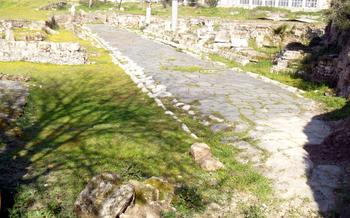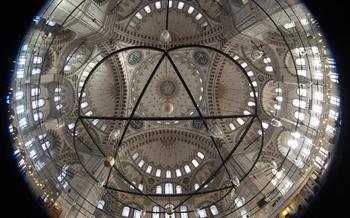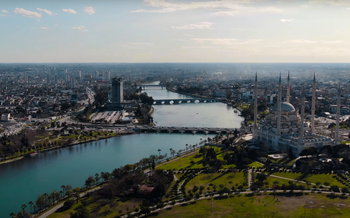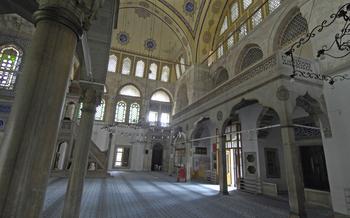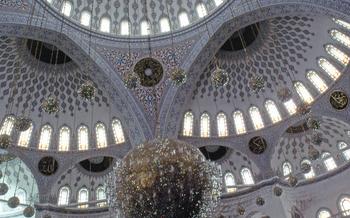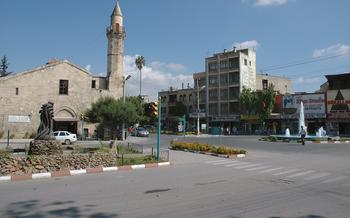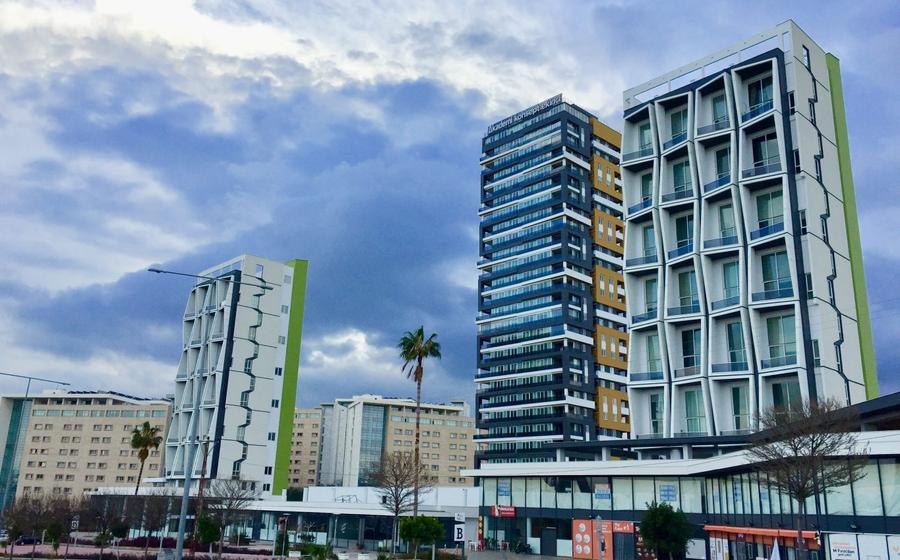
Eshab ı Kef Cave Mosque
- Eshab-ı Kehf Cave Mosque: A Sacred Haven
- The Cave of the Seven Sleepers
- Exploring the Mosque's Interior
- The Surrounding Landscape
- The Village of Tarsus
- Transportation and Accessibility
- Accommodation Options
- Food and Dining
- Planning Your Visit
- Respecting Local Customs and Traditions
- Exploring Nearby Attractions
- Festivals and Events
- Shopping and Local Crafts
- Photography Tips
- Insider Tip: Hidden Gems
Eshab-ı Kehf Cave Mosque: A Sacred Haven
Nestled amidst the serene landscapes of Tarsus, Turkey, lies a hidden gem that harmoniously blends history, spirituality, and architectural grandeur: the Eshab-ı Kehf Cave Mosque. This sacred sanctuary, named after the legendary Seven Sleepers, invites visitors to embark on a journey of faith, wonder, and cultural discovery.
The mosque's origins can be traced back to the early days of Islam, when it was built as a place of worship for the Muslim community in Tarsus. Over the centuries, it has undergone several renovations and expansions, each contributing to its unique architectural tapestry. The mosque's exterior facade exudes an air of simplicity, with its whitewashed walls and unadorned minaret, yet its interior reveals a world of intricate artistry and devotion.
The Cave of the Seven Sleepers
At the heart of the Eshab-ı Kehf Cave Mosque lies the Cave of the Seven Sleepers, a sacred chamber steeped in both history and legend. The tale of the Seven Sleepers, enshrined in the Quran and Christian tradition, narrates the miraculous story of seven young men who sought refuge in a cave during a period of persecution. According to the legend, they slept for 309 years, only to awaken in a transformed world where their faith had triumphed.
Archaeological excavations within the cave have unearthed remnants of an early Christian church, suggesting that the site has been revered for centuries. The cave's interior features several chambers, each echoing the spiritual significance of the legend. Visitors can explore these chambers, marveling at the ancient inscriptions and bas-reliefs that adorn the walls, each narrating a chapter of this timeless tale.
Beyond its religious significance, the Cave of the Seven Sleepers is also a testament to the enduring power of storytelling. The legend has inspired countless works of art, literature, and music, capturing the imaginations of generations. As visitors stand within the cave, they are transported to an era of miracles and faith, where the line between the earthly and the divine blurs, leaving an indelible mark on their souls.
Exploring the Mosque's Interior
The interior of the Eshab-ı Kehf Cave Mosque is a testament to its sacred nature and architectural prowess. The main prayer hall is a spacious and serene space, adorned with intricate designs and calligraphy. The mihrab, a niche indicating the direction of Mecca, is a masterpiece of Islamic art, featuring colorful tiles and intricate carvings. The minbar, a raised platform used for delivering sermons, is equally impressive, showcasing fine woodwork and inlaid mother-of-pearl.
Other decorative elements in the mosque include stained glass windows, chandeliers, and carpets. The qibla wall, which marks the direction of prayer, is adorned with intricate tiles and calligraphy, creating a visually captivating centerpiece. The overall atmosphere inside the mosque is one of reverence and tranquility, inviting worshippers and visitors alike to pause and reflect on the sacredness of the space.
During my visit, I was particularly struck by the intricate details and craftsmanship on display. The mihrab, with its vibrant colors and delicate carvings, seemed to come alive in the soft light filtering through the stained glass windows. The acoustics in the prayer hall were also remarkable, allowing the imam's voice to reverberate with a sense of solemnity. It was a truly immersive experience that left me with a profound sense of awe and appreciation for the beauty and sanctity of this historic mosque.
The Surrounding Landscape
The Eshab-ı Kehf Cave Mosque is nestled amidst the breathtaking Tarsus Mountains, which provide a stunning backdrop to this sacred site. The surrounding landscape is a tapestry of natural beauty, with lush olive groves, vineyards, and a variety of flora and fauna. Take a leisurely hike or nature walk in the foothills, breathing in the fresh air and marveling at the panoramic views. Pack a picnic and find a secluded spot to enjoy a meal surrounded by nature's tranquility. The picturesque surroundings offer ample opportunities for relaxation, contemplation, and appreciation of the divine beauty that envelops this sacred space.
The Village of Tarsus
Tarsus, a charming town nestled at the foot of the Taurus Mountains, holds a significant place in history as the birthplace of the Apostle Paul. Its rich cultural heritage and warm hospitality make it a delightful destination for visitors.
Strolling through the narrow cobblestone streets, one can't help but admire the traditional Turkish houses with their intricate carvings and colorful facades. The town center is a vibrant hub of activity, with shops selling local handicrafts, souvenirs, and delicious treats.
Tarsus is renowned for its culinary delights, and food lovers will be in paradise here. Must-try dishes include Tarsus kebab, a succulent lamb dish cooked on skewers, and tantuni, a local wrap filled with grilled meat, vegetables, and spices. For a sweet treat, indulge in künefe, a traditional Turkish dessert made with shredded filo dough, cheese, and syrup.
The locals of Tarsus are known for their friendly and welcoming nature. They take pride in their town and are always eager to share its history and culture with visitors. Whether you're seeking a guided tour or simply want to chat with the locals over a cup of Turkish coffee, you'll find that the people of Tarsus are more than happy to oblige.
Transportation and Accessibility
Reaching Tarsus, the home of the Eshab-ı Kehf Cave Mosque, is a breeze, thanks to its well-connected transportation network. From major cities like Istanbul, Ankara, and Izmir, you can hop on a comfortable bus or train that will take you directly to Tarsus. The journey may take several hours, but the scenic countryside views along the way make it worthwhile.
Once in Tarsus, you'll find that getting around is a breeze. Public transportation options like buses and dolmuşes (shared taxis) are readily available and affordable. They can take you to the mosque and other attractions in the city. If you prefer a more independent mode of travel, renting a car is a great option. It gives you the freedom to explore the surrounding countryside and nearby towns at your own pace.
For a hassle-free experience, you can consider hiring a private driver. They can pick you up from your hotel or the airport and take you to specific destinations, ensuring a comfortable and personalized journey. Whichever transportation option you choose, remember to plan your trip in advance, especially if you're visiting during peak tourist season, to avoid any last-minute surprises.
Accommodation Options
Finding a Place to Stay in Tarsus
When planning your trip to the Eshab-ı Kehf Cave Mosque, selecting a suitable accommodation option is crucial. Whether you prefer the convenience of a hotel or the charm of a local guesthouse, Tarsus offers a range of options to meet your needs and budget.
For those seeking a comfortable and modern stay, the Tarsus Oteli is an excellent choice. Located just a short walk from the mosque, it offers well-appointed rooms, a swimming pool, and a restaurant serving delicious Turkish cuisine. Alternatively, the Grand Hotel Tarsus provides a more luxurious experience with spacious rooms, a spa, and a rooftop terrace with stunning views of the city.
If you prefer a more intimate and authentic experience, consider staying at a local guesthouse. The Tarsus Hanım Konağı is a beautifully restored Ottoman-era mansion offering cozy rooms, a traditional Turkish breakfast, and warm hospitality. Another option is the Tarsus Konukevi, a family-run guesthouse with simple yet comfortable rooms and a friendly atmosphere.
Prices range from budget-friendly options for backpackers to luxurious accommodations for those seeking a more upscale experience. It's advisable to book your accommodation in advance, especially during peak tourist season, to secure the best rates and availability.
Food and Dining
When visiting the Eshab-ı Kehf Cave Mosque, you'll have the opportunity to savor the delectable flavors of traditional Turkish cuisine. Tarsus is renowned for its culinary delights, and there are numerous local restaurants offering a tempting array of dishes. Indulge in the succulent Tarsus kebab, a skewer of marinated meat grilled to perfection. Don't miss the tantuni, a wrap filled with tender beef or lamb, tomatoes, and onions, served with a side of hot sauce. And for a sweet treat, try the künefe, a shredded filo pastry dessert topped with cheese and syrup.
Vegetarian and vegan options are also available, ensuring that everyone can enjoy the local cuisine. Explore the vibrant markets and bazaars, where you can find fresh produce, aromatic spices, and traditional sweets. Engage with the friendly locals, who will gladly recommend their favorite dishes and guide you towards the best culinary experiences.
Planning Your Visit
When planning your visit to the Eshab-ı Kehf Cave Mosque, there are a few things to consider to make the most of your experience.
If you're short on time, a day trip from Mersin or Adana is possible. However, to fully immerse yourself in the history and atmosphere of the site, I recommend spending at least one night in Tarsus. This will give you ample time to explore the mosque, visit the Cave of the Seven Sleepers, and soak up the local culture.
As for the best time to visit, spring (April-May) and autumn (September-October) offer pleasant weather, ideal for outdoor exploration. Summer months can be hot and crowded, while winters can be chilly, so plan accordingly.
To create a well-rounded itinerary, consider combining your visit to the mosque with other attractions in the region. The ancient city of Soli-Pompeiopolis, just a short drive away, is a must-see for history buffs. The Tarsus Waterfall, with its cascading waters and lush greenery, is another natural wonder worth exploring.
Finally, remember that the Eshab-ı Kehf Cave Mosque is an active place of worship, so be respectful of local customs and traditions. Dress modestly, maintain a quiet demeanor, and ask permission before taking photographs.
Respecting Local Customs and Traditions
When visiting the Eshab-ı Kehf Cave Mosque, it is essential to be mindful of local customs and traditions to ensure a respectful and meaningful experience. Dressing appropriately is crucial, as modest attire is expected in sacred spaces. Avoid wearing revealing or tight clothing, and opt for loose, comfortable garments that cover your shoulders and knees.
Upon entering the mosque, remember to remove your shoes and place them neatly on the designated racks. Once inside, maintain a respectful demeanor and avoid loud talking or disruptive behavior. Show reverence by walking calmly and quietly, and refrain from touching or leaning against religious artifacts or decorations.
Before taking photographs, it is considered polite to ask permission from the mosque's caretakers or staff. Be mindful of other visitors and avoid capturing them in your shots without their consent. When in doubt, it is always better to err on the side of caution and respect the privacy of others.
By observing local customs and traditions, you not only demonstrate respect for the sacredness of the mosque but also contribute to a harmonious and welcoming environment for all visitors.
Exploring Nearby Attractions
Beyond the Eshab-ı Kehf Cave Mosque, Tarsus offers a treasure trove of nearby attractions that beckon the curious traveler. One such gem is the ancient city of Soli-Pompeiopolis, a testament to the region's rich historical tapestry. Explore the ruins of this once-thriving metropolis, where Hellenistic and Roman influences intertwine. Admire the well-preserved amphitheater, colonnaded streets, and intricate mosaics that transport you back in time.
Venture to the Tarsus Waterfall, a natural wonder that cascades down a rocky cliff, creating a mesmerizing spectacle. Immerse yourself in the tranquil atmosphere as the water plunges into a pool below, surrounded by lush greenery. Take a refreshing dip in the cool waters or simply relax and soak in the serenity of this hidden oasis.
Discover the Tarsus Museum, a treasure trove of artifacts that narrate the town's captivating history. Delve into the diverse collection of archaeological finds, including ancient pottery, sculptures, and inscriptions that shed light on the region's past. From prehistoric settlements to the Roman and Byzantine eras, the museum offers a comprehensive journey through time.
Festivals and Events
Tarsus, like many other cities in Turkey, comes alive during its annual festivals and events. These celebrations offer a unique opportunity to immerse yourself in the local culture and traditions.
One of the most significant events is the Tarsus Orange Festival, held every year in April. This colorful festival celebrates the city's renowned orange harvest, with parades, competitions, and traditional dances. Visitors can savor delicious orange-based dishes, witness the crowning of the Orange Queen, and enjoy live music performances.
Another highlight is the Tarsus International Theater Festival, held in June or July. This prestigious event showcases a diverse range of theater productions from around the world, attracting theater enthusiasts and performers alike. The festival offers a vibrant atmosphere, with performances held in historic venues and outdoor stages throughout the city.
For those interested in history and culture, the Tarsus Historical and Cultural Festival is a must-attend event. Held in September or October, this festival brings the city's rich past to life with reenactments, exhibitions, and workshops. Visitors can explore ancient ruins, witness traditional crafts demonstrations, and savor local delicacies while learning about Tarsus's fascinating history.
These festivals offer a chance to experience the warmth and hospitality of the Tarsus people, who welcome visitors with open arms. Immerse yourself in the vibrant atmosphere, indulge in local flavors, and create lasting memories at these unforgettable events.
Shopping and Local Crafts
Tarsus offers a delightful array of shopping opportunities, where you can delve into the vibrant world of local crafts and traditional Turkish products. The bustling markets and charming shops are a treasure trove of unique souvenirs, handicrafts, and local products.
One of the must-buy items is the exquisite Turkish carpet, renowned for its intricate designs, vibrant colors, and exceptional craftsmanship. These carpets are a testament to Turkey's rich textile heritage and make for a cherished memento.
Tarsus is also famous for its pottery, which showcases a diverse range of styles and techniques. From hand-painted ceramics to intricately glazed tiles, these pottery pieces are both beautiful and functional.
For those seeking unique jewelry, Tarsus offers an array of stunning pieces, crafted from gold, silver, and semi-precious stones. Whether it's delicate earrings, ornate necklaces, or statement rings, there's something to suit every taste and style.
Photography Tips
As you explore the Eshab ı Kef Cave Mosque and its surroundings, don't forget to capture the beauty of this sacred site through photography. Here are some tips to help you take stunning shots:
-
Utilize the Golden Hours: The golden hours, shortly after sunrise and before sunset, provide the most flattering natural light for photography. Plan your visit accordingly to take advantage of this magical light.
-
Embrace the Shadows: Don't be afraid to embrace the shadows and silhouettes that the mosque's architecture creates. These elements can add depth and drama to your photographs.
-
Experiment with Different Angles: Don't just stick to eye-level shots. Try capturing the mosque from various angles, such as from below or above, to create dynamic compositions.
-
Use a Tripod: A tripod can help you steady your camera and avoid blurry photos, especially in low-light conditions or when using a telephoto lens.
-
Play with Reflections: If there is water nearby, use it to your advantage by capturing reflections of the mosque. This technique can add an artistic touch to your images.
Insider Tip: Hidden Gems
Beyond the main attractions, there are hidden gems waiting to be discovered near the Eshab-ı Kehf Cave Mosque. One such spot is the Tarsus Waterfall, nestled amidst lush greenery just a short drive away. Immerse yourself in the tranquility of the cascading waters and enjoy a refreshing break from sightseeing.
For history buffs, the ancient city of Soli-Pompeiopolis is a must-visit. Located a few kilometers from Tarsus, this once-thriving city boasts impressive ruins, including an amphitheater, agora, and necropolis. Explore the remnants of this ancient civilization and step back in time.
If you're looking for a unique souvenir, head to the local markets and shops to find handcrafted carpets, pottery, and jewelry. These items make for beautiful mementos of your trip to Tarsus and support the local artisans who create them.
With its rich history, natural beauty, and hidden gems, Tarsus offers an unforgettable experience for travelers seeking an authentic Turkish adventure. Embrace the local culture, savor the delicious cuisine, and discover the many treasures that this charming town has to offer.

